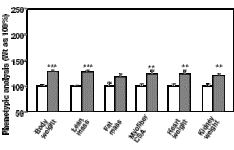New doping substance? PAPP-A helps muscles grow
Researchers have been studying the muscle strengthening protein Pregnancy-associated Plasma Protein-A for a while now. [It got its name after the protein was discovered in the blood of pregnant women – Ed.] Scientists at Loma Linda University in the US have uncovered how the protein works, and have made a mouse with mega-muscles that produce more PAPP-A.
PAPP-A is a protease: a protein that breaks down other proteins, in particular IGFBP-2, IGFBP-4 and IGFBP-5. These are binding proteins that deactivate IGF-1. So more PAPP-A means fewer binding proteins and more free IGF-1. [Structure above.] If muscle cells are damaged they make more PAPP-A.
To test their theory, the researchers created a genetically modified mouse that manufactures more PAPP-A. The figure above shows a number of characteristics of the mouse. The transparent bars represent ordinary mice, the grey ones the modified mice.
The PAPP-A mice were larger and more muscled and their organs were bigger too. They also had a little more fat, but the difference with the ordinary mice was not statistically significant for this.
If PAPP-A ever makes it to the market as a doping substance, doping hunters will probably not be able to detect it by measuring IGF-1. The amount of free IGF-1 in the blood of the modified mice did not increase. Only*inthe muscle tissue is the concentration of free IGF-1 "dramatically increased".
There is a chance that PAPP-A has quite a few side effects. It's a big protein: it consists of 1547 amino acids. It contains all sorts of multiple active domains, which probably interact with a range of other proteins, such as proMBP, complement 3 and heparin. What's more, despite its large dimensions, the protein is capable of penetrating organs such as the kidneys and the heart. So far for the possibility of side effects.
Source:*
Endocrinology. 2007 Dec;148(12):6176-85.

Researchers have been studying the muscle strengthening protein Pregnancy-associated Plasma Protein-A for a while now. [It got its name after the protein was discovered in the blood of pregnant women – Ed.] Scientists at Loma Linda University in the US have uncovered how the protein works, and have made a mouse with mega-muscles that produce more PAPP-A.
PAPP-A is a protease: a protein that breaks down other proteins, in particular IGFBP-2, IGFBP-4 and IGFBP-5. These are binding proteins that deactivate IGF-1. So more PAPP-A means fewer binding proteins and more free IGF-1. [Structure above.] If muscle cells are damaged they make more PAPP-A.
To test their theory, the researchers created a genetically modified mouse that manufactures more PAPP-A. The figure above shows a number of characteristics of the mouse. The transparent bars represent ordinary mice, the grey ones the modified mice.
The PAPP-A mice were larger and more muscled and their organs were bigger too. They also had a little more fat, but the difference with the ordinary mice was not statistically significant for this.
If PAPP-A ever makes it to the market as a doping substance, doping hunters will probably not be able to detect it by measuring IGF-1. The amount of free IGF-1 in the blood of the modified mice did not increase. Only*inthe muscle tissue is the concentration of free IGF-1 "dramatically increased".
There is a chance that PAPP-A has quite a few side effects. It's a big protein: it consists of 1547 amino acids. It contains all sorts of multiple active domains, which probably interact with a range of other proteins, such as proMBP, complement 3 and heparin. What's more, despite its large dimensions, the protein is capable of penetrating organs such as the kidneys and the heart. So far for the possibility of side effects.
Source:*
Endocrinology. 2007 Dec;148(12):6176-85.


